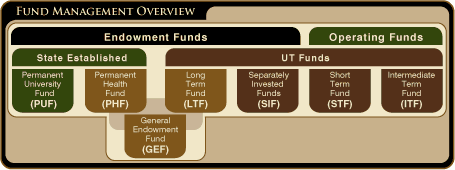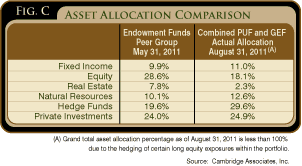Fund Management Overview
The University of Texas Investment Management Company (UTIMCO) manages the investment assets under the fiduciary care of the Board of Regents of The University of Texas System (UT Board). UTIMCO is governed by a nine member Board of Directors - three Regents of the UT Board, four outside directors with experience in investment management appointed by the UT Board, the Chancellor of The University of Texas System (UT System), and one director nominated by the Board of Regents of Texas A&M University System (A&M Board). The UT Board has delegated the day-to-day investment management responsibilities of the funds to UTIMCO, subject to compliance with UT Board approved investment policies. The UTIMCO staff includes approximately 55 specialists in various investment disciplines, as well as risk management, compliance, legal, accounting, finance and information technology.
UTIMCO invests the endowment and operating assets entrusted to its management primarily through external investment managers in accordance with the approved Investment Policies. These external investment managers are then combined into internal �mutual funds�, each with distinct time horizons and unique risk and return characteristics.

Click to print charts in this section using PDF format
Endowment Funds
UTIMCO manages four major endowment funds under the fiduciary care of the UT Board. These four endowment funds, with a combined market value of $19.9 billion, are the Permanent University Fund (PUF), the Permanent Health Fund (PHF), the Long Term Fund (LTF), and the Separately Invested Funds (SIF). Two of the endowment funds, the PHF and the LTF, are invested in shares of the General Endowment Fund (GEF), a broadly diversified pooled investment fund managed by UTIMCO. The GEF was created to increase efficiencies in managing investments, reduce costs, and streamline reporting.
Representing a permanent legacy, endowment funds provide the means to create a margin of excellence in higher education for UT and Texas A&M System�s institutions. Since endowment funds are permanent funds by their nature, they must provide for the economic needs of today while remaining intact to provide the same level of economic support for future generations, not just the next ten to twenty years, but hundreds of years in the future. The trade-off between preserving assets for tomorrow and supporting the educational and health care needs of today creates the need for a delicate balancing act in managing the endowment funds.
Balancing the competing needs of current beneficiaries, future beneficiaries and donors is the motivating force behind UTIMCO�s efforts to achieve the following two primary objectives:
- Provide for current beneficiaries by increasing annual distributions at a rate at least equal to the current rate of inflation so that real purchasing power is maintained, and
- Provide for future beneficiaries by increasing the market value of endowment assets so that future distributions to future beneficiaries will buy the same or better level of goods and services received by today�s beneficiaries (before adding any current contributions and after deducting current distributions).
Four factors affect an endowment fund�s ability to meet the competing needs of current and future beneficiaries. These factors are a) fund distributions, b) the rate of inflation, c) fund investment return, and d) fund expenses.
a) Endowment Fund Distributions (Spending). The UT Board determines the annual distributions from the endowments. The key to preservation of endowment purchasing power over the long-term is control of spending through a target distribution rate. This target rate should not exceed the funds� average annual investment return minus fund expenses and inflation over the long-term. The UT Board has approved two distinct forms of distribution or spending policies. One is the so-called �constant growth� spending policy, and the other is the �percent of assets� spending policy.
The PHF and LTF utilize the constant growth spending policy. The PHF and LTF distributions are increased annually at the average rate of inflation for the three preceding years, provided that the distribution rate remains within a range of 3.5% and 5.5% of fund asset value. The constant growth spending policy uses a smoothing formula to reduce annual volatility in spending and to maintain spending on a sustainable basis.
The PUF utilizes the percent of assets spending policy. The PUF�s annual distributions are based on a distribution rate of 4.75% of the PUF�s three-year average net asset value. This policy has been chosen for the PUF because it is best for endowments in which the current distribution is small relative to the total budget, and where long-term growth of the fund is the key objective, which are the characteristics of the PUF and its beneficiaries.
b) Inflation. Inflation erodes the economic value of an endowment fund by reducing the endowment�s purchasing power over time. Endowment assets must be invested so as to maximize the total return after inflation. The long-term expected rate of inflation is 3.0%.
c) Investment Returns. Investment returns generated by the endowment funds are determined primarily by the allocation of fund assets to different asset classes and types of investments, and by the ability of the UTIMCO staff to add value by earning returns greater than those generally available from each asset category. UTIMCO draws on years of investment experience and expertise to determine the best allocations to different categories of assets in order to achieve the returns necessary to meet objectives while endeavoring to protect endowment assets from severe losses in adverse market environments. Once allocation decisions are made, UTIMCO focuses on earning the highest returns possible within each asset category while maintaining strict risk control through a quantitative risk budgeting process and qualitative judgments. Figure A shows the investment returns earned for periods ended August 31, 2011, which are a result of these asset allocation decisions and risk budgeting processes.

Click to print charts in this section using PDF format
UTIMCO�s strategy is to invest the assets of the PUF and GEF in broadly diversified portfolios of equity, fixed income and real assets across global markets using a long-term investment horizon. In order to earn above market returns, UTIMCO also focuses on a number of different investment categories characterized by complex, illiquid, and mispriced securities where proprietary information and sophisticated investment strategies offer the opportunity for value-added returns. These asset categories have an additional important advantage. Because these assets typically provide returns which have a low correlation with those of the more traditional exchange-traded equities and fixed income securities (�More Correlated and Constrained�) in the PUF and GEF portfolios, they offer the additional advantage of diversifying and, therefore, reducing the overall risk level. These investments include hedge funds (�Less Correlated and Constrained�) and Private Investments, including venture capital, buy-out, growth, real estate and natural resources-related opportunities.
To properly diversify the PUF and GEF assets, UTIMCO invests in a broad variety of asset categories. Asset allocation policy recommendations to the UT Board are developed through careful asset allocation reviews with the UTIMCO Board in which potential returns for each asset category and investment type are balanced against the contribution to total portfolio risk by each category. An asset allocation review is undertaken by the UTIMCO staff, the UTIMCO Board and the UT Board every year.
While the allocations in Figure B iindicate the actual asset allocation as of August 31, 2011, UTIMCO repositions the allocations to each asset category and investment type from time to time in response to changes in the investment outlook, within the ranges specified in the investment policies adopted by the UT Board.

Click to print charts in this section using PDF format
While the UTIMCO staff works diligently to earn the highest investment returns possible while maintaining risk at acceptable levels, there are still risks associated with the investments held in the PUF and GEF. Equity values can fluctuate in response to the activities of individual companies as well as to general market conditions. Bond prices can fluctuate based on changes in interest rates and the credit quality of the issuers. Real assets prices respond to inflation expectations and specific market supply and demand factors. Investments in non-U.S. securities can involve political and macroeconomic risk in addition to typical individual company risks. An additional element of risk in non-U.S. investments is the currency risk, as the returns on those investments must be converted to U.S. dollars for use here. Private investments (and, to some extent hedge funds) also have an element of liquidity risk, due to the fact that some of these investments cannot be easily converted to cash at short notice. Hedge funds also often entail leverage risk.
All these risks are carefully monitored by both the UTIMCO staff and the UTIMCO Board. It is essential that some risk must be assumed in order to earn the levels of real returns necessary to meet the long term goals of the PUF and GEF. However, it is particularly important to carefully weigh each element of risk against the reward � expected future returns. The quantitative process used at UTIMCO to evaluate risks and rewards is known as risk budgeting. The UTIMCO staff is charged with carefully budgeting risks so that the risk assumed in the aggregate does not exceed the risk limits set by the UT Board. Risks are monitored daily and monthly by UTIMCO staff and quarterly by the UTIMCO Board.
Figure C indicates how the current strategic allocation of the PUF and GEF compares with a peer group of endowment funds which is comprised of endowment funds with portfolios greater than $2.5 billion and staffs utilizing private investments and hedge funds.

Click to print charts in this section using PDF format
Expenses. UTIMCO incurs expenses associated with analysis, portfolio management, custody and safekeeping, accounting, and other investment related services. Investment fees and other fees paid to external managers are, by far, the largest component of expenses. The majority of external investment manager fees are netted against the PUF�s and GEF�s asset value or capital, with the remainder being paid from fund assets.
Endowments require investment management in accordance with long-term investment objectives because of the perpetual nature of the funds. Recognizing that the investment environment will only become more challenging in the future, UTIMCO will meet the challenge by maintaining a specialized and experienced investment staff focused on adding value within a well-structured and disciplined asset allocation and risk control process.
UTIMCO�s management of $27 billion of assets, including both endowment and operating funds, provides for exceptional economies of scale in the investment of the assets. The ratio of UTIMCO�s management fee to assets under management was .067% for the year ended August 31, 2011.
Click for the next page >>